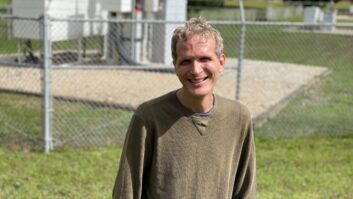Open Mic: Steve Fluker
Feb 1, 2007 12:00 PM, By Chriss Scherer, editor
The NRSC Releases Paper on Surround

The National Radio Systems Committee (NRSC), the cooperative effort of the National Association of Broadcasters and the Consumer Electronics Association, has been involved in evaluating radio broadcast technology and establishing standards for the benefit of all broadcasters and receiver manufacturers. The Digital Radio Broadcasting subcommittee has been active in recent years as IBOC, and the Ibiquity HD Radio system in particular, is developed.
The Surround Sound Audio Task Group (SSATG) was created to evaluate the available surround technologies and provide some insight on to how surround can be implemented on digital and analog terrestrial radio broadcasts. The group’s latest effort is a paper that discusses surround on radio. The Task Group is co-chaired by Steve Fluker, director of engineering of Cox Radio Orlando. Radio magazine talked with Fluker about the forthcoming paper to gain some insight to its content and what it provides to broadcasters.
Radio: Give us an overview of the paper, including the reasons for its creation and the benefit will provide to radio stations.
SF: The paper was created to provide an informational and educational document for broadcasters to use as a resource. It covers a broad range of information, starting on a basic level. It answers the common questions: What is surround? What are the issues involved with using it? What are the available systems?
Radio: As a review, what are the systems available systems today?
SF: There are four companies or groups developing systems. All four can be placed into one of two categories: composite and component. The composite systems include matrixed systems (SRS Circle Surround and Dolby Surround) and watermarked systems (Neural Audio). The only component system is the MPEG Spatial system.
Radio: Give us an overview of the contents of the paper.
SF: There are five main sections in the document that was approved by the NRSC at its meeting at CES in January. The sections cover the systems available and their differences; implementation of surround; cross-compatibility of the various systems; multicasting; the effect of surround on an analog signal, with particular attention to multipath; and testing and monitoring. In addition, there are five annexes in the paper. The first four are provided by the system developers to describe their own systems. The fifth annex provides greater detail on the multipath evaluation from the main portion of the paper. In all, the main paper spans about 30 pages.
Radio: Does the paper apply to AM and FM or only FM?
SF: Because AM is only capable of transmitting lower bit-rates, the paper only covers information applicable to FM and its 48kb/s or higher bit-rate.
Radio: The question �which system is the best?� has been debated for some time. What is the view of the SSATG?
SF: While the component system � MPEG Spatial � provides the most accurate reproduction of the surround field, it requires a full 5.1 backbone in the facility. The encoding must be performed at the end of the air signal chain to sync the surround data stream with the stereo audio. Currently, automation systems are not designed to store a stereo signal and a synchronous data stream. It’s difficult to do right now.
Radio: Where does a station begin if it wants to transmit a surround signal?
SF: The most basic implementation is to install one composite encoder in one studio and use it to downmix all surround content to stereo. The next step would be to modify a production studio to create surround mixes for promos and commercials. This studio could also be used to manually downmix surround to stereo.
Radio: The two tradeoffs are perfectly accurate reproduction of surround vs. cost of conversion. The most accurate system (MPEG Spatial) requires the most extensive facility modifications. The least expensive approach provides a quality surround reproduction that may slightly degrade the surround field.
SF: My recommendation is to build a new studio today with 5.1 bus and backbone. When a station wants to implement surround, it can do so easily without major changes. The majority of existing studios have already gone through consolidation and are built with a stereo backbone. After spending so much money on constructing new studios in one building, it’s difficult to ask the stations to come back and rip out the infrastructure to change it to accommodate 5.1. I don’t see that happening. Converting one or two rooms slowly and using a composite system will be the more common way to implement surround sound.
Now that the surround paper is complete, the SSATG is on hiatus until its next project is decided. The surround paper is expected to be released in February. View the report at this link:
nrscstandards.org/DRB/SSATG report final.pdf
Online Extra:
A podcast of portions of the interview with Steve Fluker is available online. Access it and other Radio magazine podcasts at beradio.com.












